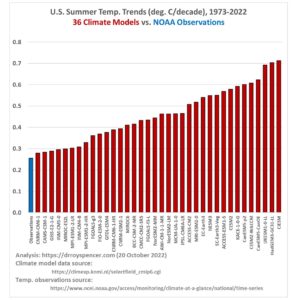by P. Gosselin, Sep 27, 2023 in ClimatChangeDispatch
On September 24th, 2023, Kasha Patel, a writer for The Washington Post (WaPo) created a story that is likely in the top 10 most false and egregious climate scare stories ever published.
Titled, “Scientists found the most intense heat wave ever recorded — in Antarctica,” the story isn’t just false, it is doubly so because the research paper it is based on is also seriously flawed. [emphasis, links added]
In this case, peer review at Geophysical Research Letters (GRL) failed to catch and correct the most basic abuse of the definition of a “heat wave.”
The leading paragraph of the WaPo story said:
In March 2022, temperatures near the eastern coast of Antarctica spiked 70 degrees Fahrenheit (39 degrees Celsius) above normal — making it the most intense recorded heat wave to occur anywhere on Earth, according to a recent study.
At the time, researchers on-site were wearing shorts and some even removed their shirts to bask in the (relative) warmth. Scientists elsewhere said such a high in that region of the world was unthinkable.
WaPo also provided a normal temperature, for reference with some “unbelievability” from the lead author of the paper.
Temperatures in March, marking a change into autumn on the continent, are typically around minus -54 degrees Celsius on the east coast near…Dome C. On March 18, 2022, temperatures peaked to minus -10 degrees Celsius. That’s warmer than even the hottest temperature recorded during the summer months in that region — “that in itself is pretty unbelievable,” said Blanchard-Wrigglesworth, an atmospheric scientist at the University of Washington.
First, it is important to point out that the so-called “heat wave” really wasn’t warm at all; the shorts and shirt removal were completely for show, rather than science.
Since most people in the United States use the Fahrenheit temperature scale, which isn’t mentioned at all in the WaPo article citing the actual high temperature recorded, it was easy for reporter Kasha Patel to sneak by the idea that it was actually warm at the time.
-10 Celsius is actually 14 degrees Fahrenheit – which isn’t warm, much less a “heat wave” by any definition. Patel can’t be forgiven for not mentioning this in the article because anyone can get the conversion simply by typing it into Google, like this example.
But that isn’t the worst journalistic violation Patel makes.
…



 This second business-as-usual prediction was that there would be 1.8 C° warming from preindustrial times to 2030. Deducting the 0.45 C° warming up to 1990, the prediction amounted to 1.35 C° or about 0.34 C°/decade. Thus, IPCC predicted 0.3-0.34 C°/decade medium-term warming. However, only 0.14 C°/decade has occurred since 1990
This second business-as-usual prediction was that there would be 1.8 C° warming from preindustrial times to 2030. Deducting the 0.45 C° warming up to 1990, the prediction amounted to 1.35 C° or about 0.34 C°/decade. Thus, IPCC predicted 0.3-0.34 C°/decade medium-term warming. However, only 0.14 C°/decade has occurred since 1990